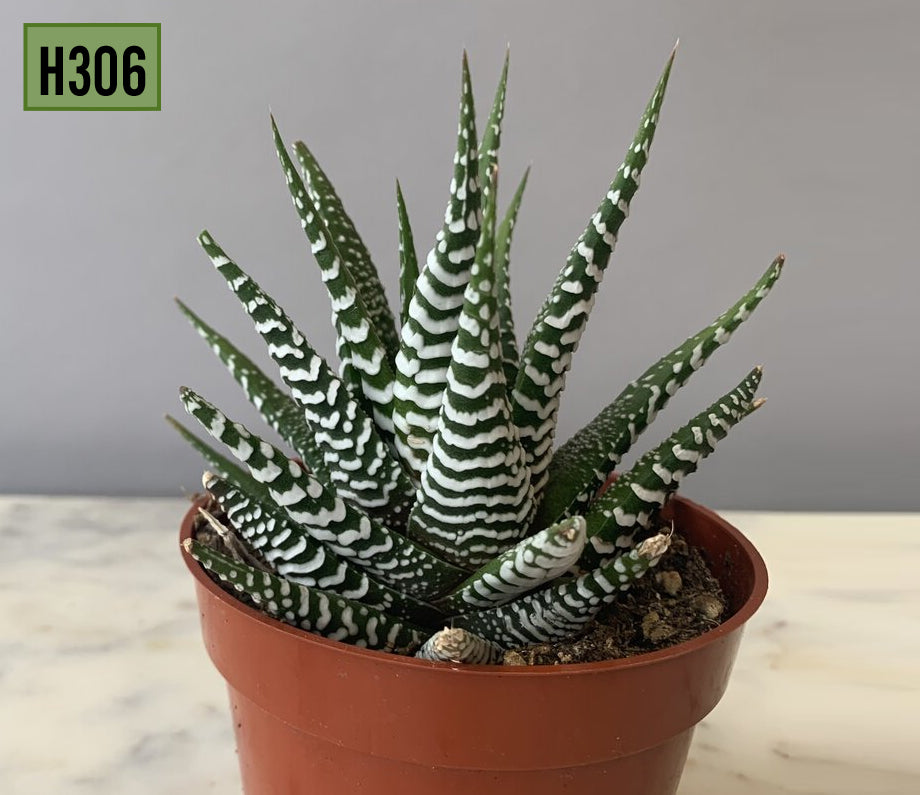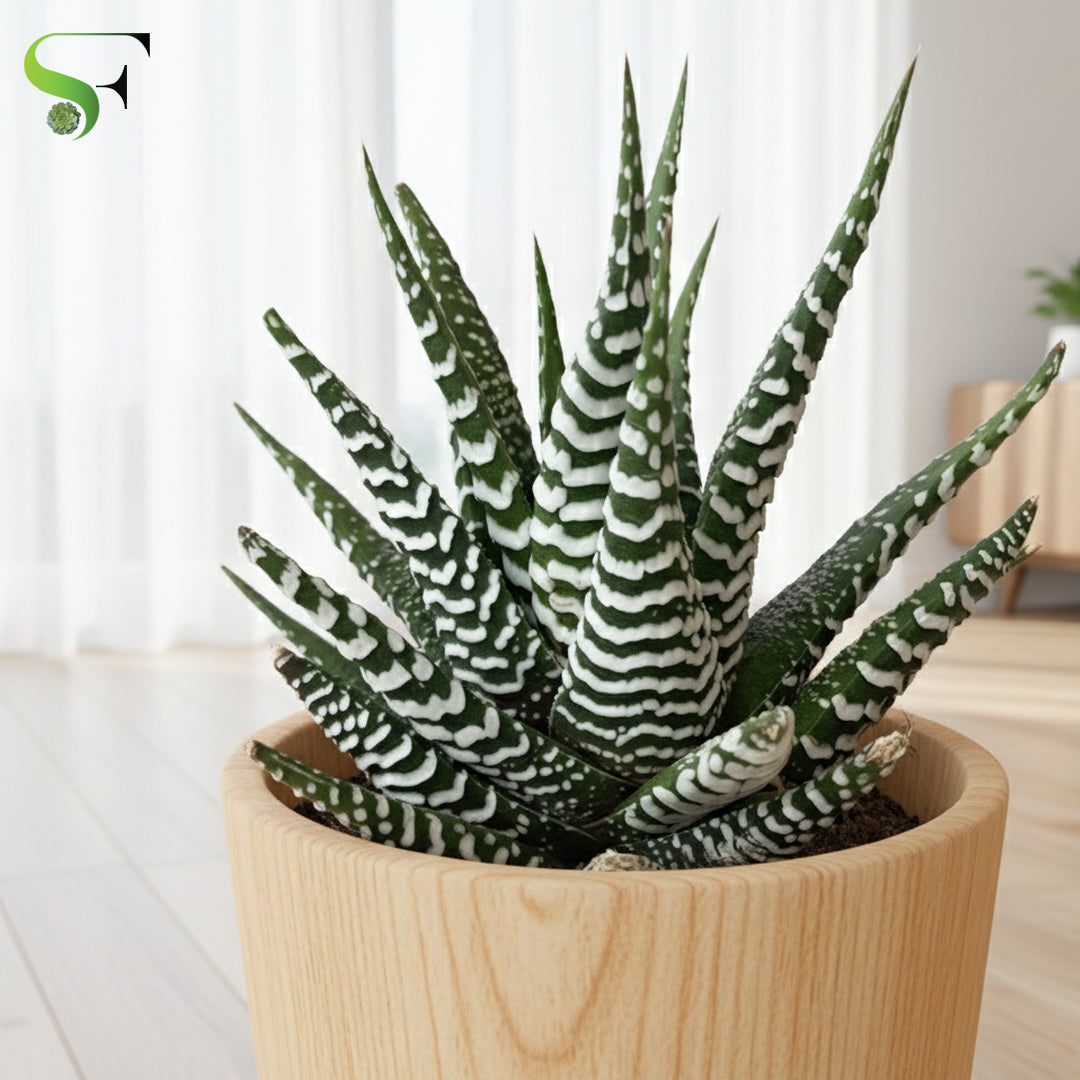Zebra Haworthia
Zebra Haworthia
Couldn't load pickup availability
ALL THE PLANTS WILL BE SENT BAREROOTED. NO POTS. NO SOIL
Haworthiopsis fasciata, commonly known as Zebra Haworthia or Zebra Plant, is a striking and popular succulent prized for its unique architectural form and bold striped pattern. Its resemblance to a zebra's stripes makes it a favorite among succulent collectors and an excellent choice for a low-maintenance, eye-catching houseplant. This plant is often confused with Haworthiopsis attenuata, but H. fasciata is generally more compact and has smoother inner leaf surfaces.
Detailed Description
Haworthiopsis fasciata is a small, stemless succulent that forms a dense rosette of thick, fleshy leaves. The leaves are a dark green and are triangular in shape, tapering to a point. The plant's most notable feature is the raised, white, wart-like tubercles or bands that are arranged in horizontal stripes on the outer, underside of the leaves. This distinct pattern is what gives the plant its "Zebra" name.
The rosettes are typically compact, growing to about 4-6 inches (10-15 cm) in diameter. Over time, the plant will produce small offsets, or "pups," around its base, which can create a beautiful clumping colony.
In late spring or early summer, a mature Zebra Haworthia can produce a tall, slender stalk with small, inconspicuous, white, tubular flowers. While the blooms are not as showy as the foliage, they are a sign of a healthy and happy plant.
Growing Tips
The Zebra Haworthia is a resilient and forgiving plant that thrives on neglect.
-
Sunlight: This succulent prefers bright, indirect light. In its native habitat, it often grows in the shade of other plants, so it is not accustomed to intense, direct sun. Too much direct sunlight can scorch its leaves and cause them to turn a reddish or yellow color. An east or west-facing window is ideal, as it provides bright light without the harsh intensity of the midday sun. It also does well in office environments with fluorescent lighting.
-
Fertilizing: Fertilize sparingly. During its active growing season (spring and summer), you can apply a diluted succulent or cactus fertilizer once every two months. Avoid fertilizing in the fall and winter when the plant is dormant.
-
Pruning: Pruning is not necessary. You can remove any dead or dying outer leaves to keep the rosette tidy.
Temperature and Hardiness
Haworthiopsis fasciata is well-suited to indoor environments and warmer climates.
-
Temperature: It thrives in average room temperatures, generally between 65°F and 80°F (18°C and 27°C).
-
Hardiness Zones: It is not frost-tolerant and should be protected from freezing temperatures. It is best grown outdoors only in USDA zones 9-11 or brought inside during colder months.
Water Requirements
Overwatering is the most common cause of problems with Zebra Haworthia. This plant is highly drought-tolerant and stores water in its thick leaves.
-
Watering Frequency: Use the "soak and dry" method. Allow the soil to dry out completely before watering again. Water thoroughly and deeply, but ensure all excess water drains from the bottom of the pot.
-
Seasonal Changes: Reduce watering significantly in the cooler, dormant months. The plant can go for a month or more without water during the winter.
Soil Preparation
Well-draining soil is essential to prevent root rot.
-
Ideal Mix: A commercial succulent or cactus potting mix is an excellent choice.
-
DIY Mix: You can create your own gritty mix by combining potting soil with inorganic materials like perlite, pumice, or coarse sand. A mix with a high percentage of inorganic material (50% or more) is highly recommended for optimal drainage.
-
Potting: Always use a pot with a drainage hole. Terracotta or clay pots are often a good choice because they are porous and help to wick away excess moisture from the soil.
Propagation
Propagating Zebra Haworthia is a straightforward process and a great way to expand your collection.
-
Offsets (Pups): This is the easiest and most successful method. Mature plants will naturally produce small plantlets or "pups" at their base. Wait until the pup has at least four leaves and a small root system. Gently separate it from the parent plant using a clean, sharp knife or your fingers. Allow the cut to callous over for a day or two before planting the pup in its own pot with well-draining soil.
-
Leaf Cuttings: While possible, this method is less reliable. Carefully remove a healthy, plump leaf from the base of the plant, ensuring you get the entire base. Let it callous for a few days, then place it on top of well-draining soil. Be patient, as rooting can take several weeks or even months.
#ZebraHaworthia #Haworthiopsis #Succulent #HaworthiaFasciata #SucculentCare #Houseplant #LowMaintenancePlants #GardeningTips #PlantPropagation #DroughtTolerant
Share




